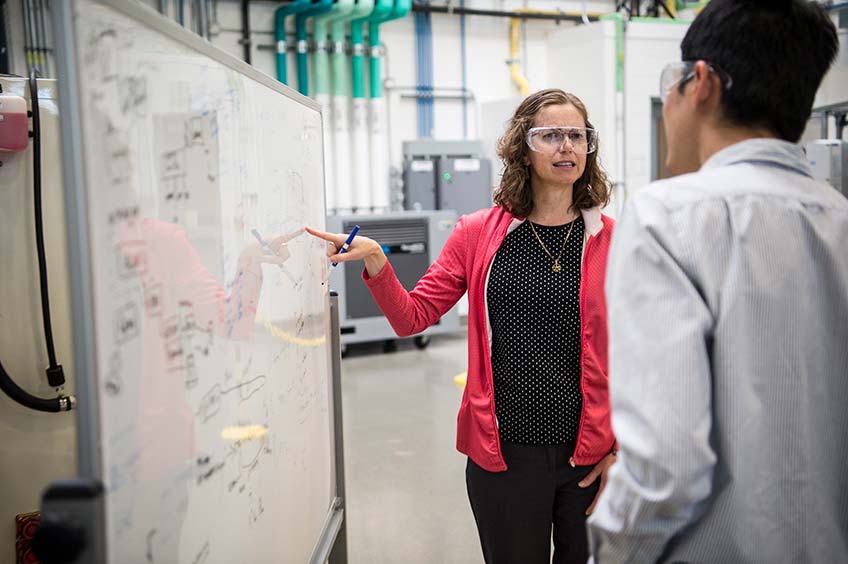
A study by Environment America revealed that solar energy capacity has more than doubled in 45 of America’s 57 largest cities over the past six years and ‘solar installer’ is one of the fastest growing professions in the U.S. In fact, it is estimated that the industry is worth $17 billion and is on track to double again in the next five years. It’s predicted that the 2020s will be the decade that solar becomes the dominant new form of energy generation.
Despite this roaring success and modern approach to power generation, the solar energy industry is still arguably operating in an antiquated way when it comes to its workforce. The energy sector was predominantly male-driven in the past and, unfortunately, this problem still exists. Although there has been some improvement over the years, women are still severely underrepresented in the sector.
With the recent ‘Bleak’ U.N. Report revealing that countries have failed to halt the rise of greenhouse gas emissions despite repeated warnings from scientists, and that China and the United States are the two biggest polluters – further increasing their emissions last year – it’s clear that there is still a long way to go until targets are reached. But to do this, we need more women in the workforce.
Female representation in the sector
Unfortunately, the boom in solar energy production and consumption has not equated to a boom in female workers. A recent study found that there are only 64,000 women working in the industry, which is just 26% of the overall workforce.
According to a recent report which summarized the findings of a survey among 1,500 respondents from 144 countries working in the industry, female representation in renewable energy is also low, at just 32%.
This imbalance is persistent on a larger scale. In the energy sector, women account for a mere 26% of the total workforce, and their representation at higher levels in the organization is even less: 23% of managers and 17% of board members are female, on average.
Why is this a problem?
A lack of female talent in the solar energy sector can cause a number of issues. Firstly, it leads to skills shortages being continued for longer than necessary. The sector has been battling with extensive talent shortages for several years now, which has caused many projects left uncompleted or severely delayed.
A large proportion of the workforce is expected to be reaching retirement age within the next few years, and this means that they will be taking their skills and knowledge with them. There are simply not enough professionals entering the sector to replace them and learn the critical skills needed to ensure the sector continues to thrive.
As solar energy is becoming increasingly more popular, the number of projects will be rising rapidly, and it’s vital that we find enough people to run these initiatives.
Business case
By attracting more women to the solar energy sector, skill gaps can be plugged quicker, which of course means budgets will not be stretched, project deadlines can be hit and existing workforces won’t be overworked.
In addition to the obvious ‘manpower’ women can bring, female talent can also help companies reach business goals quicker and positively impact bottom lines. In recent years there have been multiple studies published that have shown that companies employing a higher percentage of women typically have a more positive and meaningful work culture, increasing employee retention, and that having women on corporate boards increases profitability and ROI. For example, a study of 171 German, Swiss, and Austrian companies revealed a clear relationship between the diversity of companies’ management teams and the revenues they get from innovative products and services.
As well as bringing more diversity in approach and skills, women can also help businesses reach their clean energy goals and can often be more passionate about renewable energy for its ethical case. On average, females are slightly more likely to be concerned about the environment and have stronger pro-climate opinions and beliefs, according to a Yale report.
Additionally, research from Boston Consulting Group has shown that women-owned startups generate on average 10% more revenue than male-owned startups. This clearly shows why businesses, including those in the energy sector, should ensure women have an equal opportunity to advance at every step of their career.
Why is there a lack of women in solar energy?
There are a number of contributing factors to why there is such a lack of female professionals found in solar energy talent pools. One of the key reasons is the low number of female students in STEM subjects. Unfortunately, in the past, science, tech, engineering and maths were portrayed as ‘masculine’ subjects and females were not encouraged, as much as men, to study these topics. The renewable energy sector, in particular, failed to be promoted as a career of choice to both men and women.
A lack of access to flexible working options can also deter individuals from joining the sector. With many women having to take career breaks to raise children, it’s important that part-time and flexible hours are available for everyone. Workplace cultures must shift, and clearly show the evolution of the industry, where diversity and inclusivity is accepted and encouraged.
What businesses must do
Just as there are global calls for more renewable energy options for consumers, so to should there be worldwide outcry at the lack of women working in solar and other sustainable energy sources.
Businesses must actively promote the many exciting opportunities and global solar energy projects to women. However, employers must also ensure that these opportunities are flexible and practical for working mothers and carers, as females are often responsible for children and ageing parents.
To attract a diverse group of experts for future projects, and ensure more skilled female graduates are entering the sector, businesses should ensure that they are engaging with school age children and attending career fairs. High-profile female professionals need to be more vocal about their amazing careers – and employers should be fully behind this.
Introducing more women to the renewable sector and creating greater equality is not only fair and the ‘right thing to do’, but it’s also imperative for business success. Making an effort to include and attract the other half of the population, and bringing their skills onboard will help projects be completed quicker, and get us closer to the eco-friendly world that we all want to see.
***
Lara Anton is responsible for the client management of Samuel Knight International’s renewable energy portfolio.
The views and opinions expressed in this article are the author’s own, and do not necessarily reflect those held by pv magazine.
This content is protected by copyright and may not be reused. If you want to cooperate with us and would like to reuse some of our content, please contact: editors@pv-magazine.com.








“A lack of female talent in the solar energy sector can cause a number of issues. Firstly, it leads to skills shortages being continued for longer than necessary. The sector has been battling with extensive talent shortages for several years now, which has caused many projects left uncompleted or severely delayed.”
WOW, really, REALLY? DO what the good ol’ boys DO. Get your ‘team’ together. Line up finances, groom your target group, in this case women and open up your business. Don’t (talk) about what should happen, setup your program get the business going and see who lasts in the workforce. IF you want more women in the alternative energy workforce, then YOU put in the time and effort to make it happen. You can ‘talk’ percentages and averages, but can you make the change to create the opportunities for women to populate the alternative energy arena. NO, you pontificate unfairness while pointing out statistics. Actually get involved and MAKE the difference. So, to ‘get’ all you figure you need in the business sector, what you’re proposing is part time jobs, with variable hours and more employees to cover a day’s work load. Also isn’t it interesting this same business model is being expanded upon across all sectors of business? Part time workers, flexible hours, no benefits under 40 hours a week and an unrealistic pension plan when one gives their all, doing the hard work of installing those 40 pound plus panels on roofs all over the land.
In this day and age of social media “influencers” who have enough of a following on their personal web page can make from $250 thousand to $1 million dollars a year, “showing people how to use products”. If they become celebrities, then the pay check goes into the millions, perhaps billions. Do you think these folks want to hump around 40 pound solar panels, get sun burned and melanomas for their years of service, in what adds up to a part time job? Really, REALLY?
C’mon Anton, lead, follow, or get out of the way.
Id hire all the women I could find that ACTUALLY had and interest. I think that starts at a very young age. not much I can do when I’m looking for the right talent in a pool of 20 somethings. that said, not all positions require swinging a hammer or turning a wrench. what about accounting, planning, zoning, leadership, real estate? there are lots of positions that need talent that women are just as capable of as men. But, don’t think this is a male-only field. the best railing I ever saw built on a historic home I own was built by a woman. I’d hire her in a heartbeat. so goes the installation of anything. just have to make sure women are raised to know they can do it, just like my daughter.